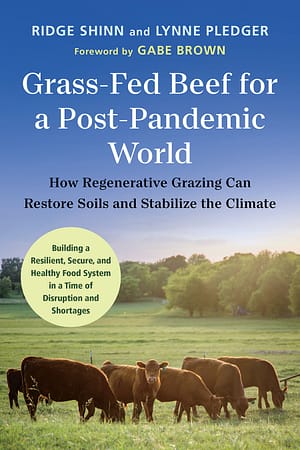Feeding the World: Why Regenerative Grazing Is So Important

How can we learn from our mistakes and pave a way for sustainable, nutritious, local meat? In Grass-Fed Beef for a Post-Pandemic World, Lynne Pledger and Ridge Shinn take readers on a journey through production agriculture to show how regenerative grazing can benefit our climate and environment.
The foreword below by Gabe Brown, bestselling author of Dirt to Soil and pioneer of the soil-health movement, highlights the true significance of this practice.
The following is an excerpt from Grass-Fed Beef for a Post-Pandemic World by Lynne Pledger and Ridge Shinn. It has been adapted for the web.
Grass-Fed Beef for A Post-Pandemic World: A Foreword by Gabe Brown

Relying on a lifetime of experience with cattle and resource conservation, Ridge and Lynne take us on a journey through production agriculture in the United States. They explain how farmers and ranchers went from grazing livestock on pasture to confining cattle in grassless pens where grain and by-products are brought to them—grain and by-products that are grown with synthetics (fertilizers, pesticides, and fungicides) and the heavy use of fossil fuels. These practices, in no small part, have led to the degradation of our soils, our waters, and, at least to some degree, our health.
This has led many to vilify animals, cows in particular, and falsely claim that they are largely responsible for climate change. This book helps to set the record straight: This new method of grazing cattle has a net climate benefit. As Ridge and Lynne so truthfully state, “Regenerative grazing will change the way our society thinks about beef, because the grazing itself is as significant as the meat.”
The Significance of Grazing
The act of grazing as significant as the meat itself? Yes! Few are aware of just how important it is for plants to be grazed. For eons, the simple act of an herbivore biting off part of a plant has led to what Dr. Allen Williams refers to as “positive compounding effects.”

Ridge and Lynne take a deep dive into this soil health, plant health, animal health, and human health connection. It is this connection that has the ability to bring us together. No matter where your interest lies—be it climate change, clean water, profitability for farmers and ranchers, the revitalization of our rural communities, or improved human health—regenerative agriculture, driven by adaptively grazed cattle, can address many of the issues we face as a society. We can come together, finding common ground for common good.
I believe that we must continue to educate ourselves, no matter what profession we are in. To keep honing our skills, we must learn from those with experience. In Grass-Fed Beef for a Post-Pandemic World, Ridge and Lynne share their lifetimes of experience. In fact, every chapter highlights stories of people, places, and predicaments that Ridge encountered over the years as his understanding of grass-fed beef production developed.
I learned from this book and am confident that you will, too.
— Gabe Brown, June 2022
Recommended Reads
All About Cows: What has Four Legs, Says “Moo,” and Could Save the Planet?
Recent Articles
Oxeye daisies are one of the most important plants for pollinators including beetles, ants, and moths that use oxeye daisies as a source of pollen and nectar. Instead of thinking about removing a plant like oxeye daisy, consider how you can improve the fertility and diversity of habitat resources in your home landscape, garden, or…
Read MoreSo you want to start reaping your harvest, but you’re not sure where to start? Learn how to break down the options of harvesting tools!
Read MoreWhat’s so great about oyster mushrooms? First, you can add them to the list of foods that can be grown indoors! They are tasty, easy to grow, multiply fast, and they love a variety of substrates, making oyster mushrooms the premium choice. The following is an excerpt from Fresh Food from Small Spaces by R. J.…
Read MoreEver heard the phrase, “always follow your nose?” As it turns out, this is a good rule of thumb when it comes to chicken manure. Composting chicken manure in deep litter helps build better chicken health, reduce labor, and retain most of the nutrients for your garden. The following is an excerpt from The Small-Scale Poultry…
Read More








